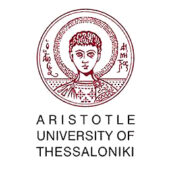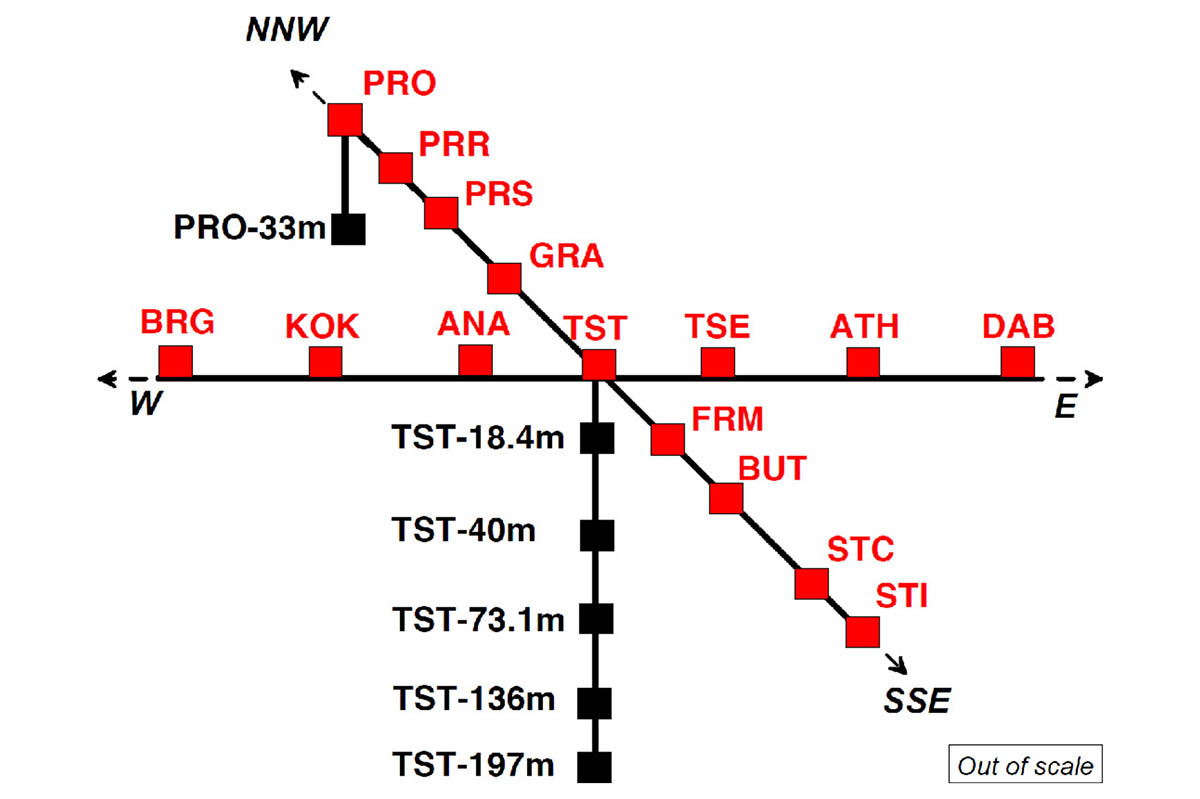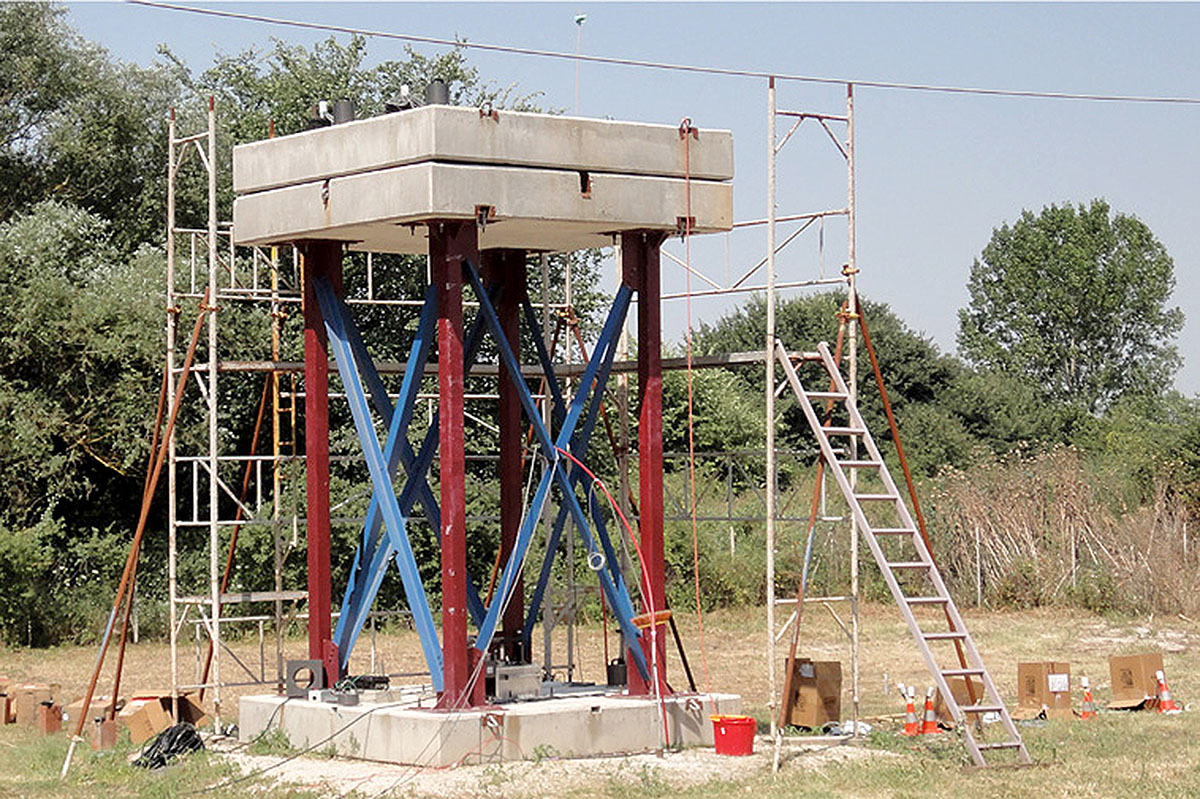Surface (BRG, KOK, ANA, TST, TSE, ATH, DAB, PRO, PRR, PRS, GRA,FRM, BUT, STC, STI) and borehole (PRO-33m, TST-18.4m, TST-40m, TST-73.1m TST-136m, TST-197m) stations of the accelerograph network of the Mygdonian basin EUROPROTEAS model structure with instrumentation
EUROSEISTEST is deployed in an active seismic zone that generated the strong M6.4 earthquake in 1978. It is the longest-running (since 1993) test site of its kind on a global scale and operates in the best-known valley in the world, both from a geometrical, geological, and geotechnical point of view. Its unique geotechnical features, i.e., soft soil conditions and liquefaction-prone areas, make it an excellent site for testing and validating numerical models to generate new knowledge in site characterization, soil dynamics, geotechnics, ground motion, site-effects, and wave propagation. Several hundreds of down-hole and cross-hole investigations, passive array microtremor measurements, and more than 20km of P- and S-wave refraction and surface-wave inversion surveys have been conducted in EUROSEISTEST combined with an extensive laboratory program to estimate the dynamic properties of all soil categories down to the rock basement and to develop a detailed and highly accurate 3D geophysical/geotechnical/geodynamic model of the whole valley. EUROSEISTEST comprises an ideal site to perform interdisciplinary research for site characterization in complex geological and geotechnical environments, to apply new monitoring techniques, to use and check new methods and tools for 3D site and geodynamic imaging, and to perform advanced studies in ground motions, soil dynamics, site characterization, wave propagation, and engineering seismology.
EUROPROTEAS is one of the very few active existing field large-scale facilities to study soil-structure interaction and wave propagation. It is a model structure with variable stiffness resting on soft soil in the center of the EUROSEISTEST instrumented valley. It has been extensively used for soil-structure interaction tests and wave propagation studies in the ground and the building. The site with its monitoring infrastructure can accommodate other large scale model structures, complementing EUROPROTEAS, to perform dedicated research activities in SSI and the investigation of innovative seismic and dynamic isolation techniques.
EUROSEISTEST and EUROPROTEAS are supported and complemented by a small-scale shaking table with different laminar boxes, as well as by excellent laboratory, field-testing, and surveying apparatuses, comprising numerous all kinds of soil dynamics and geophysical testing equipment. Data from EUROSEISTEST and EUROPROTEAS have already generated more than 100 scientific publications in peer-review journals and conferences.
Services currently offered by the infrastructure:
EUROSEISTEST has operated since 1993 and EUROPROTEAS since 2012. The facility has been used to study wave propagation in actual soil media under actual earthquakes, forced vibrations, or controlled explosions, which may also trigger liquefaction phenomena. Moreover, other soil-borne types of excitations (serial explosions in the ground, vibro-shaker, eccentric mass shaker) may be used to study distortion of the wavefield around a point of interest produced using metamaterials. Researchers and technical staff of AUTH provide technical and scientific support to the existing data acquisition, manipulation, and the design and implementation of new experiments. The properly archived data and metadata are being disseminated to the scientific community. AUTH researchers constantly work on the uninterrupted operation of the infrastructure and the improvement of the capacity and quality of its data. The rich record of previous and ongoing research projects, the individual or organizational subscribers of the EUROSEISTEST mailing list, and the analytics of the traffic in EUROSEISTEST’s web portal demonstrate the great and widespread interest from worldwide users.
Different teams (recently within the SERIES, SERA, NERA projects) have used EUROSEISTEST and EUROPROTEAS facilities to study ground motion, SSI, and wave propagation at a large scale in the field with different experimental setups of the structure, the foundation soil conditions, and the testing configurations. The EUROPROTEAS facility has also been used to perform initiation research studies on the efficiency of geotechnical seismic isolation (using soil-rubber mixtures) for different types of vibration and to study incoming wave distortion and isolation using different metamaterials. Experiment design, instrumentation, excitation, test execution, data processing, and archiving are provided by highly-trained and experienced personnel of AUTH.
Modality of access under this proposal:
Users or user groups will be provided with the chance to choose between two different types of use of the EUROSEISTEST infrastructure: (a) Remote use of the EUROSEISTEST network and/or EUROPROTEAS installations and existing databases and (b) in person execution of surveys and tests-experiments with the assistance of the AUTH staff to access the infrastructure, design and implement user-specific research.
Case (a) users will be provided full access to the existing and future databases of EUROSEISTEST and EUROPROTEAS experiments and surveys. The scientific group of AUTH will support them in taking advantage of existing datasets and metadata according to their requirements. Case (b) users will schedule visits to the EUROSEISTEST and EUROPROETAS infrastructure to design and conduct experiments. Such tests can be on soil-structure interaction, innovative seismic isolation materials (geotechnical seismic isolation), wave propagation in structures, site characterization, microtremor, and strong motion array measurements, and testing and validating innovative low-cost sensors (MEMS). From the significant gained knowledge and experience of the SERA project and several national and University projects, the actual duration of each test can be accurately estimated depending on its specific features. The typical duration of an average experimental setup and test in EUROSEISTEST facility is approximately thirty days and includes five days of in-person access to the test site area for geophysical/geotechnical tests and twenty-five days of design, preparation, instrumentation, data acquisition configurations and processing, validation checks, and training at the lab. A typical test in EUROPROTEAS takes approximately forty days: thirty days are needed to design the test, configure the instrumentation, prepare the testing facility and install the instrumentation, develop code for in-situ data visualization and processing; five days for executing the experiment itself, and five days for downloading and disseminating the data from the data acquisition system, which typically includes data from more than one hundred instruments and sensors. Typically, several days or even weeks of scientific support may be requested to design the test process and interpret obtained data after the test. The two facilities can be jointly used for combined research tests on liquefaction effects on structures, and wave propagation in media may also be envisaged.
The unit of access for both installations of EUROSEISTEST/EUROPROTEAS corresponds to one day and covers “hands-on” use of the infrastructure (one day of experimenting at the test site), or one day of training of the users on how to use available scientific equipment, or one day of instruments preparation/calibration/testing, or one day of scientific consulting of the user/users group on how to process/interpret their data or re-process already available data to fit specific user/users group needs. The unit cost also includes all kinds of consumables, maintenance costs, and necessary subcontracting.
Support offered under this proposal:
Users will be offered complete scientific, technical, logistic, and training support to use the EUROSEISTEST/ EUROPROTEAS facilities for their visits to Thessaloniki in case of “on-hands’’ use. They will also be offered access to all kinds of laboratory and field-testing facilities, including geophysics, to assist the requirements of the testing proposal. Guidance and advice on the particular design of each test will be provided to users by senior members of the Research Unit of Soil Dynamics and Geotechnical Earthquake Engineering (SDGEE, https://sdgee.civil.auth.gr/), who is responsible and run EUROSEISTEST and EUROPROTEAS. Whenever deemed necessary, other members of the Geotechnical Division of the Dept of Civil Engineering may also offer their expertise in a broader range of fields. The inner work will be carried out at the Laboratory of Soil Mechanics and Geotechnical Earthquake Engineering. Users will be hosted in their own office, made available throughout their hands-on visit to AUTH. The actual tests will be run in the field at EUROSEISTEST /EUROPROTEAS. Transportation and accommodation will be arranged and provided by AUTH throughout their visit. During the post-test phase, users will be provided with support on specialized software to download and process the data from the testing instrumentation and acquisition system. Incoming users will interact daily with doctoral and post-doctoral researchers working in similar fields of interest. Web-conferencing facilities of SDGEE will be used for continuous communication during the design phase, which might not require the in-situ presence of the users. Users will be provided with all material pertinent to the design and execution of the test (manuals, presentations, reports, videos), made available online. Finally, incoming users are free to explore all facilities offered in the AUTH campus and its outskirts, such as banks, restaurants, student cafes, library, university gym, and medical assistance at the university hospital.
Outreach to new users:
Outreach to new users is pursued through (a) the proposal of a large number of innovative and cutting edge field experimental activities (TA) using the experimental facility of EUROSEISTEST/EUROPROTEAS in combination with small scale laboratory tests in the laboratory shaking table, (b) the release of existing and future EUROSEISTEST/EUROPROTEAS data (i.e., numerous seismic and ambient noise records, past tests on SSI and wave propagation in EUROPROTEAS produced by external excitation means) and metadata through a dedicated open-source web portal (http://euroseisdb.civil.auth.gr), (c) the advertisement of the web portal via electronic mail to the broader engineering and seismological community, (d) the operation of a EUROSEISTEST/EUROPROTEAS mailing list to send out periodic updates of the undergoing research and status of the infrastructure, (e) scientific publications in top international journals and conferences, which include extensive descriptions of the existing infrastructure and overall research, and (f) personal communication with individual scientists.
Besides, EU funding of this TA will provide fundamental support to the proper and undisturbed operation of the whole infrastructure. Moreover, it will provide specialized scientific and technical staff with high experience designing and executing experiments in the EUROSEISTEST/ EUROPROTEAS unique field facility. Finally, EU funding will guarantee the training of future infrastructure users and/or re-formatting, supplementing, and augmenting data according to the specific needs of a user group. EU funding is also vital for designing and implementing specialized innovative, cutting-edge, and curiosity-driven experiments that will fit the exact research needs of the call requirements.
Because EUROSEISTEST/EUROPROTEAS is a real-scale field laboratory, users/ interest in running tests is increasing. This increased interest was evident during the SERA project, where nine different research groups used the offered TA units. We expect that the number of transnational users of EUROSEISTEST/EUROPROTEAS will increase due to this proposal because of the additional advertisement through the open TA calls. We expect that the number of publications pertinent to our infrastructure and its unique capacities that will appear in the peer-reviewed literature will reflect such an increase.
Review procedure under this proposal:
For details on the TA evaluation process, please refer to Task 1.2 of WP1 and the process followed by the TA-SEP in particular.




